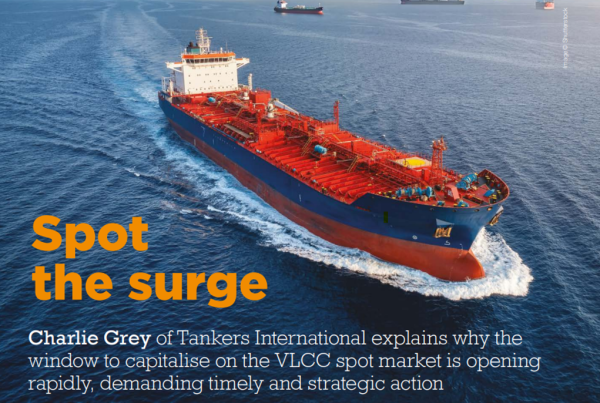Editorial published in Transport & Logistics Middle East on 7 October 2022
It was widely predicted that we would finally see the VLCC market recover this year. After two years marred by challenging oil demand and Covid restrictions, this year seemed to promise a return to ‘normal’ as restrictions were lifted, and OPEC committed to continuous supply increases.
Happily, as we enter the latter stages of 2022, we can say that VLCC demand is well on the way to recovery. Rates have risen exponentially in recent months, in contrast to the historic lows at the start of the year. Interestingly, these headline figures have masked another story; VLCC trade routes are changing.
A geographic shift
Oil demand and production increased dramatically during the first half of 2022. This was primarily driven by the easing of Covid-19 restrictions that had artificially depressed global demand since late 2019, alongside the impact of the Ukraine invasion, which has affected energy security.
Tankers International proprietary data shows that this has created a definite global increase in VLCC fixtures on the spot market. We saw an additional 27 monthly VLCC spot market liftings during the first half of this year globally, when compared to the 2021 average. This leaves the sector very close to matching pre-Covid average fixing volumes.
Yet, this recovery has not been uniform. The Arabian Gulf has seen the fastest recovery in volumes to date. This is unsurprising, given that many OPEC members in the region initially cut oil supply levels in response to Covid-related decreases in demand and are now increasing production at a steady pace.
The number of VLCC fixtures in the Middle East has increased steadily over the last two to three years and has now surpassed pre-Covid levels (2019 averaged 156 liftings per month). In the Arabian Gulf alone, we counted an additional 26 liftings per month in the first half of this year compared to last. We note further expansions going into the third quarter and count 189 VLCC liftings in the Arabian Gulf in September this year.
While Europe has not historically been a major receiver of crude oil in VLCC parcel sizes, this year we have seen a marked shift. As the continent has reduced the amount of Russian oil taken in the wake of the country’s conflict with Ukraine, we have seen a dramatic increase in demand from alternative suppliers, such as the Middle East but also the US and South America. Much of this volume has moved on VLCCs as freight levels in the segment have been competitive compared to the smaller tanker types, that have traditionally carried crude oil to Europe.
Traditional VLCC receivers east of Suez have also seen increased volumes, including India and Singapore. During the first half of the year we noted a reduction in VLCC cargoes heading to China, this trend has however reversed and September saw a surge in activity into the country. This latest demand surge is driven by a declining oil price and move away from sanctioned Russian oil.
Staying ahead of a moving market
Where this rate of change is unusual, it is not completely unsurprising. Tanker markets have always moved quickly and will continue to do so well after the global economy has moved forward from the consequences of Covid-19 and recent geopolitical issues.
The past few years have proven that not all paradigm-shifting events are reasonably foreseeable. Yet, detailed analysis is still critical in navigating the VLCC market – ultimately, profits are driven by understanding how fundamentals are evolving and likely to evolve in the medium to long term and understanding the exact market conditions as you negotiate a fixture.
It can be easy to miss out on potentially lucrative market movements if you do not have the data to create strategy and informed decisions. Negotiating positions may leave the other side in a particularly advantageous position, or longer-term decisions – such as on time charters or dry docks – could leave you missing out on headline rates.
Harnessing this data is one of our core values at Tankers International. By leveraging the strength and unique scale of our VLCC pool, we can secure data and information that would otherwise not be available to any of our pool participants – which we turn into actionable insights, that help maximise earnings.
This approach was the motivator behind the development of our VLCC Fixture app, which we believe is creating a healthier market by opening information on fixtures up to the wider shipowning, chartering, broking, cargo owning, and investing community. Subscribers benefit from segmented and searchable information on fixtures updated every 5 minutes that was previously the preserve of a select few. This includes TCE breakdowns and cargo forecasts – which can allow users to reliably take advantage of an evolving market.
Oil logistics is now facing unchartered territory, especially in the Middle East. Capitalising on today’s market requires tools to succeed – such as the weight of a tanker pool, ideally combined with a robust set of data to enable informed decisions.
By Charlie Grey, Chief Operating Officer (COO), Tankers International









